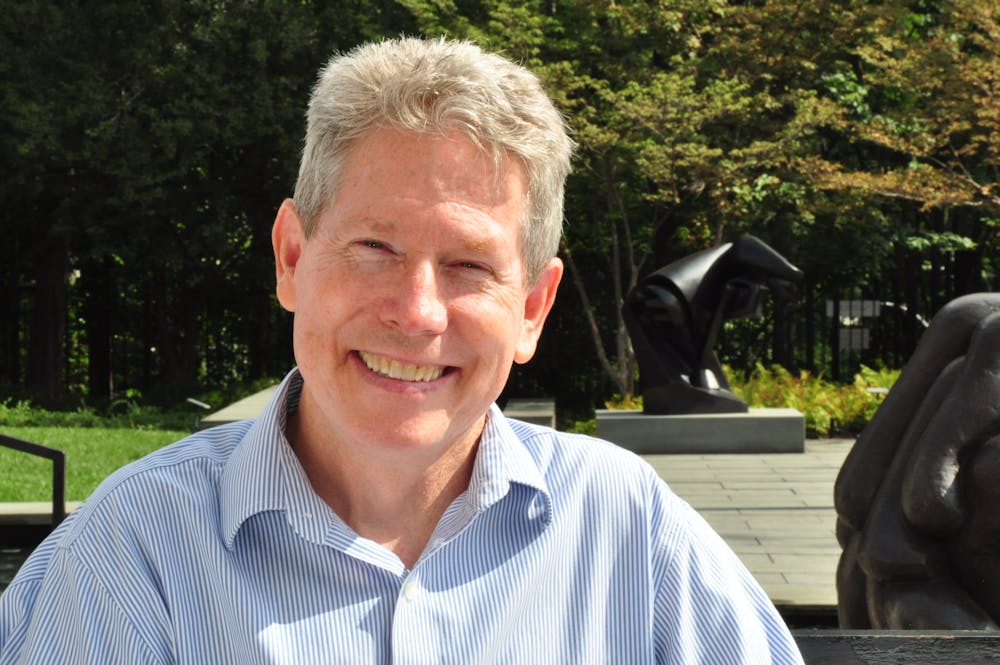John Shields, the chef and owner of Gertrude's, has devoted his life to celebrating Chesapeake Bay cuisine. In an interview with The News-Letter, he reflected on his early culinary influences, the evolution of Chesapeake Bay cooking and how students can help protect the region’s food economy.
The News-Letter: Could you share the story behind how your business got started?
John Shields: I'm from Baltimore originally, but I cooked around. I lived in the San Francisco Bay area for 20 years and ran a few restaurants there. In about 1996, I came back to Baltimore to do a Public Broadcasting Service series, Chesapeake Bay Cooking with John Shields. Someone told me that the restaurant space at the Baltimore Art Museum (BMA) was up for sale. I looked at it and thought, “You know, I think I like this. I think that this could work.”
I wanted something high profile but not in the Inner Harbor. I was looking for more of a destination spot. The location near Hopkins and the Sculpture Gardens — which is absolutely gorgeous — really cinched the deal. We gutted the place, rebuilt it and set out on a mission to champion the Chesapeake Bay. That’s what we’ve been doing for 26 years.
N-L: I know from your website that Gertrude is your grandmother. Would you mind telling me about Gertrude?
JS: It's kind of interesting that I ended up where I started out. My grandmother lived right down the street at around 25th Street and Greenmount Avenue, which is where I was born.
My grandmother used to cook at Saint Anne's church, which had a huge hall and a massive kitchen. Back in the 1950s and 1960s, they were raising money for the church, and she was in charge of preparing lunches for businessmen. I started helping her out in the kitchen when I was a little kid. She really was my mentor, teaching me the importance of feeding people — whether it was family, friends or the neighborhood. She's the one who inspired me.
And you know, there’s a funny connection between me and BMA. Every year on Charles Street, they used to have Easter parade that ended at the museum. Everybody would be all dressed up. I found pictures of my father bringing me to the museum when I was about five or six years old, standing right in front of it.

COURTESY OF JOHN SHIELDS
John stood in front of the BMA as a young boy.
N-L: For someone who isn’t familiar with the Chesapeake Bay culinary scene, can you speak to what characterizes it? What’s important to know?
JS: When I was growing up, Chesapeake cuisine was really about the ingredients native to the region — things like crab, oysters and rockfish. But, I think all cuisines, especially regional ones, are constantly evolving. If you look at Chesapeake cuisine historically, many of the early recipes were rooted in Western European traditions. Then, as different waves of people came, they added flavors. When Italians arrived, suddenly that became part of what people thought of as Chesapeake cuisine. And then the Germans, the Irish and many others. It’s like a painting made from a diverse palette!
N-L: What does Chesapeake cuisine look like today?
JS: Today, it's exciting because it's so diverse. We’ve had waves of new immigration. A good portion of my kitchen now is from El Salvador. I quickly realized how we could incorporate all these different cultural elements into the food.
My opinion of what Chesapeake Bay cooking used to be and what it is now has changed, but it's still a celebration of everything that we have in this amazing watershed. [The Chesapeake Bay] is the largest estuary in North America, and, from the mountains of the Appalachians down to the shore, we have so much to work with. That's what Chesapeake is: a celebration of all these things, interpreted in many, many ways.

COURTESY OF KRISTIN REILLY
N-L: You’ve done a lot of work toward preserving the food economy of the Chesapeake Bay region. As college students, how can we help?
JS: The best thing we can do is buy locally as much as we can. For Hopkins students, a great way to do is by meeting me at the 32nd Street Farmer’s Market in Waverly! I'm there every Saturday morning. Even better, you get to meet people behind the produce, which is very important because you can't take care of a place if you don't know it. We have to be rooted, even if it's just while we're living there.
The Farmer’s Market can always use help and volunteers. When we go over to the Farmer’s Market, we're also a little bit more mindful of getting fresh vegetables, fruits and starches. It helps us make a more plant-forward meal plan, putting less stress on things like chicken, beef and seafood.
Another way to help is through local projects. The Baltimore City Master Gardeners work in little gardens throughout the city. The Baltimore Orchard Project needs volunteers during different times of the year. They go out to many places with fruit trees where no one is living anymore, gather the fruit and take it to the food bank or pantries. It’s a great way to know neighborhoods and build a sense of community.
There's also a number of Baltimore City gardening plots. If you’re here for four years, or even longer for graduate school, you could get a plot, grow your own food and share it with other people. It really connects you to everything — you’ll meet people, other growers and learn even more from them. Ultimately, it's about getting involved, getting out of yourself and being there in the community.
N-L: Do you have any advice for people who are beginning to cook while trying to live a healthy, environmentally-conscious lifestyle?
JS: I think staples like oats, barley and rice are great things to include in your regular meals. You can add different ingredients to them in so many ways. They’re good for the environment, good for your gut and great for getting your day started, and they don’t need much else to supplement them. For example, if I have a container of steel cut oats in the fridge, I'll just put a little flaxseed, a touch of honey and some oat milk — boom, I'm done!
For lunch, you can take any of those grains, especially rice, toss it with some vinaigrette, and you’ve got a rice salad. You can put vegetables or a little chicken in, and it’s a simple, healthy meal. And, of course, you can see how that same concept can translate into dinner.
I also recommend getting together with friends once or twice a week to cook a meal together. And it’s okay if the meal is a bit more decadent, you know? It’s about balance. It’s always finding that balance.

N-L: You’ve mentioned so much about community and culture and history and its connection to cooking. What does cooking mean to you?
JS: To me, cooking means nurturing and taking care of others. What I do is hospitality, and the word comes from the same root as hospital, which traces back to hospice. In the monastic traditions, when the world was falling apart during the Middle Ages, hospice was the place where people could come to be cared for.
I have a nonprofit, and it's called Our Common Table. I called it that because it brings us together – not only to celebrate, eat and to be nurtured, but to talk. I can talk to people who may have different viewpoints, but when we all sit around that common table something happens: Connections are made.
People always ask me, “How do you do what you do? How did it all come together?” And I tell them, “You know what? The secret is you just get up every morning and show up for life.” Get out there and everything will happen. You don't have to know all the answers. Just show up, and things will start to fall into place.





